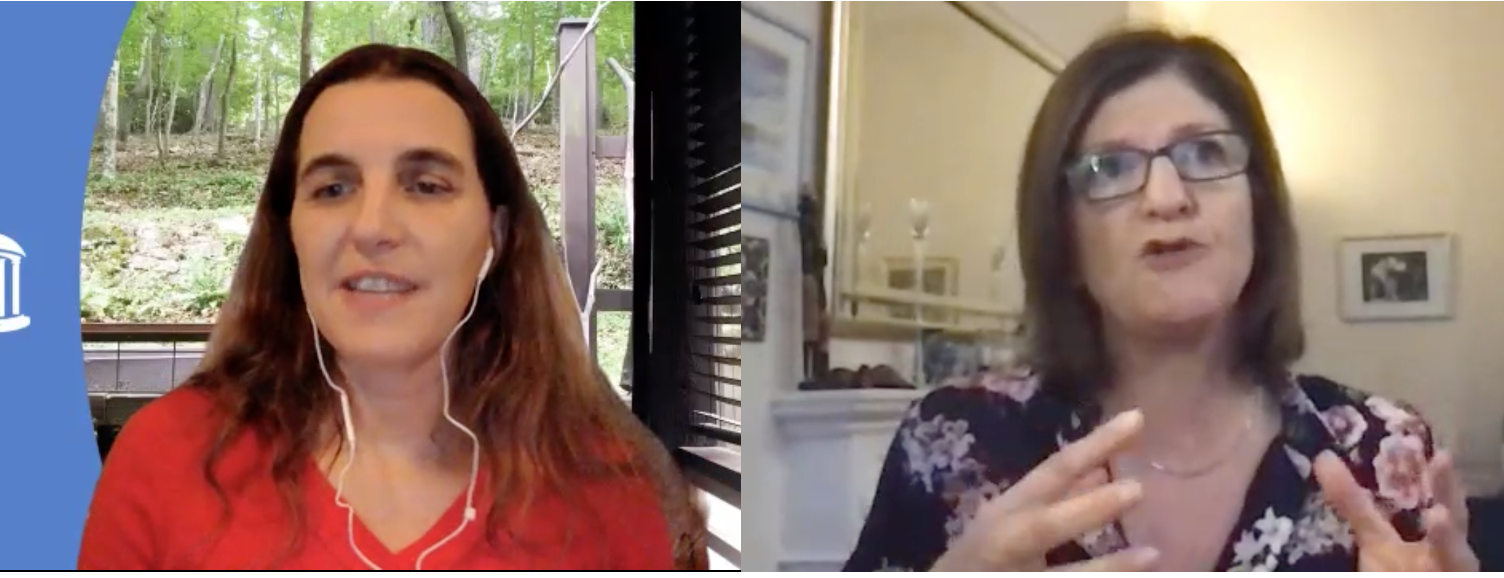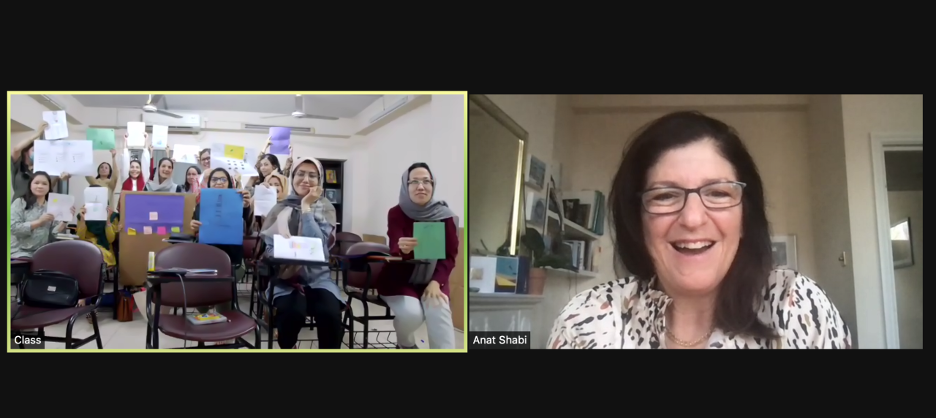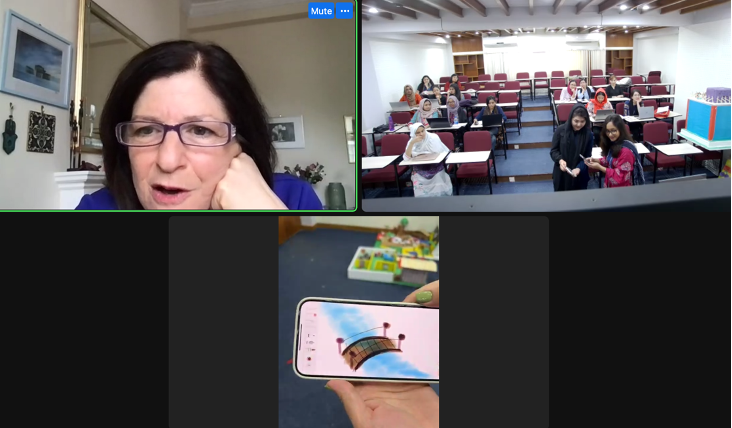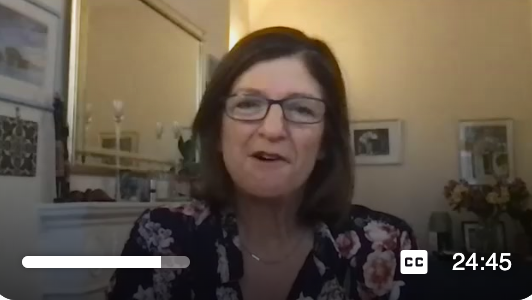Getting Underneath the Question: An Interview about LEGO Serious Play with Anat Shabi

Lego Serious Play (LSP) is an open-source moderation method that uses Lego bricks to facilitate strategic planning, team building, problem-solving, and creative expression. Participants work both as individuals and as a group to build simple models representing various concepts in response to a question posed by the facilitator. Robert Rasmussen describes serious play as ‘an intentional gathering of participants who want to use their imagination, agree that they are not directly producing a product or service, and agree to follow a special set of rules’ (Rasmussen Consulting, 2012).
During the design thinking classes in the Master of Education program at the Asian University for Women, I had the pleasure of welcoming Anat Shabi, coach and LSP expert for the 2022 and 2023 student cohort, where she conducted short, interactive sessions on LSP – that worked even without Legos.

AUW Class 2022 – LSP Prompt: Build (or draw) a tower. Tell me what makes it your tower. Place yourself on it, and describe the view.

AUW Class 2023 – LSP prompt: Build (or draw) a bridge. What does the bridge represent? Place yourself on the bridge, and add the things that create happiness for you.
Both times I was amazed by the creations and stories students shared, and also by the personal insights that I gained. The first session taught me how to ask better questions, in the second one I learned to better connect what I value with my professional trajectory. Her visits were a student favorite. Here’s the teaching fellow’s perspective:
“The Lego Serious Play workshop was an incredible learning experience for me because it was unique, especially in the sense that it was so simple, and the whole brainstorming process was really enjoyable, but it’s only after you complete the task or workshop when you understand that you’ve learned a complex analysis of your own and other people’s perspectives, only by practicing a very short, fun exercise!” (Israt Jahan Oeeshi)
Video Interview
In the interview, Anat draws on her experiences to generate ideas for educators.
Edited Transcript
Stefanie Panke: It’s an absolute pleasure to welcome Anat Shabi to AACE Review for a conversation on Lego Serious Play. As a professional coach, what first drew you to Lego Serious Play?
Anat Shabi: What you’re trying to do all the time with coaching is to get underneath the question, because what people come to you with is actually not the core of what their challenge is. I came to Lego because I was on a very creative kind of coaching program where we used different tools to introduce creativity and really get into the heart of what people were thinking. So that planted the seed in my mind. The next thing to happen, as always, is that somebody actually invited me to a workshop where a colleague was showcasing Lego Serious Play. And as soon as we were doing it, I was thinking, “Oh, my goodness, this would be amazing if we apply it to training and coaching.” So then I embarked on a whole course of being upskilled, learning LSP, and adding it into my own toolkit.
‘You end up feeling a bit more positive about whatever’s going on’
Stefanie Panke: For those who aren’t familiar, can you briefly explain the main rules of Lego Serious Play?
Anat Shabi: It is a very playful method. You’re bringing the joy, you’re bringing the engagement. People are feeling more relaxed because you’re playing, and the defensive part of the brain is dialed down. There are four key steps, and the first one is the build question. Lego Serious Play, is indeed serious play. So there’s always, always, always a purpose. Otherwise, you’re just building with Lego, which is fun. But you’re not getting to the crux of what you’re looking for. The skill for somebody who is facilitating and training with Lego is to design the right question. It needs to be simple enough so that the person on the other end can engage with the challenge.
The second is then the fun part, the creation part, the building part, because that’s when you’re really trying to move the person along from where they’ve started to an endpoint. Sometimes we are just stuck, but because you are building, you’re creating, and because our brain is just so wonderful that it will always try and make sense of any patterns that you put in front of it, the thinking then starts to follow along. It’s called Thinkering, actually, tinkering and thinking.
The next stage is sharing because, let’s face it, up until now, whatever you’ve been thinking is totally in your head. We want to get it out. We want you to articulate it so that you can hear what it sounds like. That’s when you get the connection. And that’s when you get the other person asking you questions about what you created, which then stimulates even more thinking and even more insights, which is amazing.
And then the final piece is really just to take a few minutes to think about what on earth has just happened, because you will have moved, you will have changed or formed or imagined something new.
So that in a nutshell is what this process is about. It’s really a wonderful way to creatively think, get unstuck, connect with other people. And just also change your mindset. So you end up feeling a bit more positive about whatever’s going on.
‘Playfulness is what gives everyone that psychological safety’
Stefanie Panke: What do you think Lego Serious Play methodologies have to offer for classroom settings? Can they enhance learning processes? Can they spark creativity in a typical K-12 or higher education setup?
Anat Shabi: Yeah, oh my goodness, I would love to see it in the classroom, and in fact, we have piloted a few things. But I think the main thing to say about Lego Serious Play is that it’s not for every question. When the answer is yes or no, or when you don’t need a collaborative approach, or you don’t need to reflect on anything or examine anything, you don’t need to spend time because it is a time investment to engage with this process.
It’s very much a tool that builds on the theory of constructivism. So it’s not so much about giving you new information. It’s about building on what you already know, or maybe what you’ve already learned in the classroom. It’s a great tool for gauging collaborative thinking in a group environment, particularly in situations where maybe you’ve got a classroom where some people are shy, some people are more reflective. This is a lovely way of having everybody involved because the other rule about Lego Serious Play, and you’ve seen this in your classroom, is that everybody gets to build, and then everybody gets to share. So everybody feels like they’ve had a voice, and everybody feels like they’ve been heard, and more so they’ve been understood.
Stefanie Panke: Are there principles of Lego Serious Play that teachers can apply in settings that do not necessarily involve the physical bricks?
Anat Shabi: Very good question, and I think this is something that I’ve had to contend with during the pandemic because obviously, this was a great way to connect and have dialogue with lots of people, but they had to have Lego bricks. And so I was looking at ways to get around it. And I think for me, the application is in the playfulness and in the creativity. What you get with the bricks is that repetitive clicking action that manages to relax the brain. So any activity that is repetitive and relaxing would work, like drawing for example. The principle works so long as you apply creativity and an element of playfulness, because the playfulness is what gives everyone that psychological safety. I’m not going to be judged, I am playing, and that’s when people share what is really important to them. And that’s what you want. You want to have honest conversations.
‘The human touch has to remain, otherwise, what’s the point?’
Stefanie Panke: What are some emerging trends or future directions that you foresee at the interaction of creativity, education, and technology, especially considering generative AI?
Anat Shabi: I think humans are amazing to have come up with this tool. The way we use it has to be creative. It’s a wonderful tool, a brilliant tool for imagining and diversifying different ways of looking at things. For example, one of the things I said about the Lego play method is that it does have to be simple, but it’s not always simple when you’ve got a big question to ask. It’s not always simple to cut it up into little steps so that people go on a journey. I think you can definitely use AI for that. You can use it to introduce more creativity. It’s a great tool for helping us share information.
At the end of the day, though, you don’t want to lose the element of connection. So how do we still connect with people? And how do we harness that amazing talent we have for interpreting things? So yes, we’ve got AI. But what is our twist on it? How are we going to interpret what we’ve come up with? How are we going to ensure that we are still being creative when looking at tools that are tactile?
Especially as we’re moving online, how do we bring that element of touch to the forefront? Because we don’t want to be looking at screens all the time. I think there are a lot of questions there, and I’m sure that many people in education are listening. Perhaps they’re even designing or adapting some of their classes based on what the AI is coming up with. But at the end of the day, you’re the one feeding the AI. You’re the one posing the questions and analyzing and deciding what to do with the output. The human touch has to remain, otherwise, what’s the point?
Stefanie Panke: On a practical note, could Lego series play, like building and presenting Lego models, be a more cheat-proof assessment option for educators?
Anat Shabi: Well, if students are asked to create something, it brings a joyful element. Engaging them in the process of thinking with a creative tool like Lego series play could be effective. If they prepare a model or drawing and narrate their story, it could be a great exercise. This approach might be cheat-proof since it requires personal input and storytelling. I think the engagement is really high, not just for the person building, but also for the other person. Because, imagine you’re presented with a visual, and you have no idea what it means. You’re relying on the other person to narrate it for you, and I think that then builds curiosity for you. So you’ve got a closer bond, if you like, being built between the students, but also between the students and the lecturer, which is always great.
‘Serious play helps you to be totally present in the moment’
Stefanie Panke: You use Lego series play to explore mental health and emotional well-being. I noticed on LinkedIn that you engaged in a lot of volunteer work in this space. Can you tell me a little bit more about what you did and what you learned in the process?
Anat Shabi: Sure, I didn’t realize my LinkedIn activities were so closely followed! During the pandemic, I ran sessions that people said made them feel better. In 2023, I was happy to bring workshops focusing on mental health. The joy and presence in the moment these activities bring are beneficial. It’s not about severe mental health issues but helping people cope with stress and pressure through a self-help method. Serious play helps you to be totally present in the moment, and that means that any distractions or any thoughts that are going on for you completely dial down.
Stefanie Panke: You modeled that for the students at the Asian University for Women during your classroom visit. It was baffling to see how building a simple Lego bridge could reveal so much about personal priorities and happiness.
Anat Shabi: It becomes a learning experience, doesn’t it? And any learning experience that is joyful and has that visual prompt becomes very memorable. So maybe if it’s so memorable you don’t have to cheat.
Stefanie Panke: Where can people learn more about your work and Lego series play?
Anat Shabi: LinkedIn is a great place to start. I post a lot there, including case studies and highlights of workshops and other initiatives involving playfulness in education. Feel free to contact me there for more information.
About
 Anat works with small-business owners and their teams to help get them unstuck and solve their ongoing, time-consuming challenges. An experienced business trainer and coach, Anat combines her successful management experience in the corporate world with engaging, creative methods for learning and development. An advocate of Lego®SeriousPlay® Anat often weaves this powerful method into her sessions to help participants gain focus and generate new solutions to achieve their goals. During the pandemic, Anat began to explore the role of creativity in wellbeing. She continues to successfully use the Lego®SeriousPlay® method to boost mental health well-being, facilitate meaningful inclusive conversations and to help participants build strong connections. To find out more, connect on Linkedin
Anat works with small-business owners and their teams to help get them unstuck and solve their ongoing, time-consuming challenges. An experienced business trainer and coach, Anat combines her successful management experience in the corporate world with engaging, creative methods for learning and development. An advocate of Lego®SeriousPlay® Anat often weaves this powerful method into her sessions to help participants gain focus and generate new solutions to achieve their goals. During the pandemic, Anat began to explore the role of creativity in wellbeing. She continues to successfully use the Lego®SeriousPlay® method to boost mental health well-being, facilitate meaningful inclusive conversations and to help participants build strong connections. To find out more, connect on Linkedin

